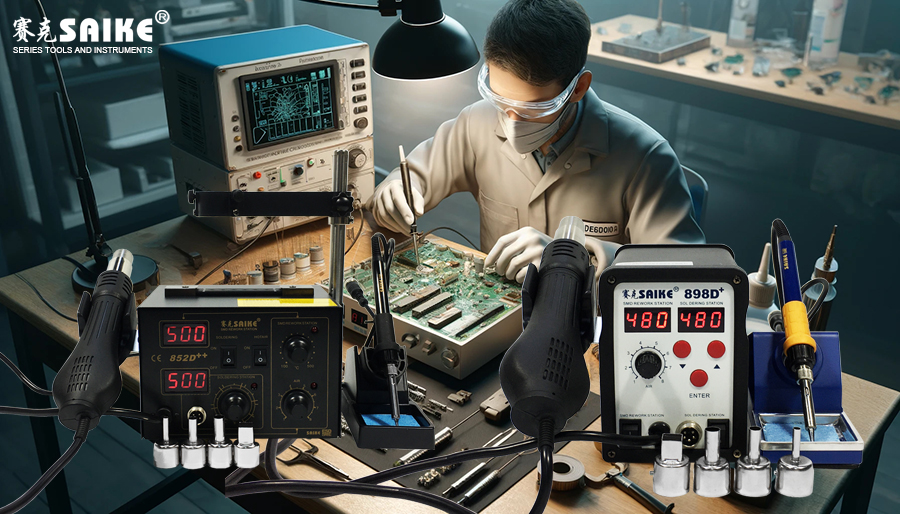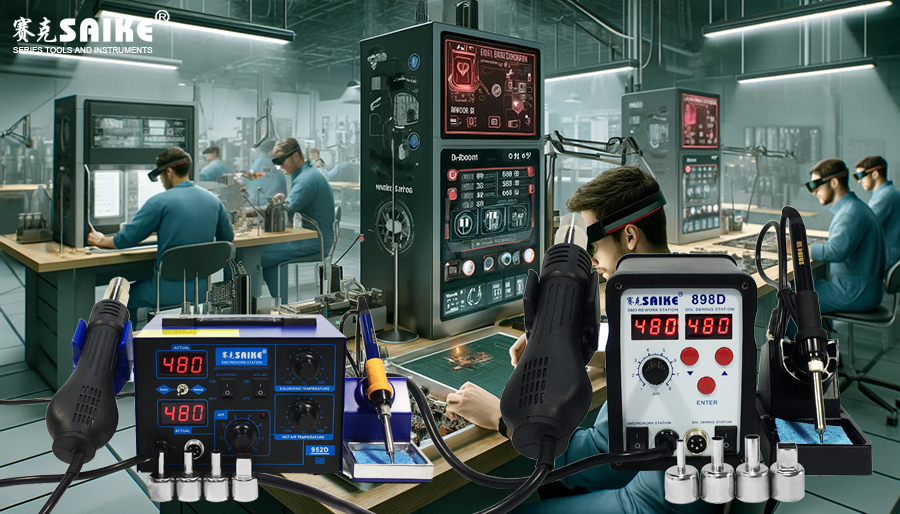
SK-YJ000RFCHT-KP 100016
The hot air rework station is a crucial tool in electronic manufacturing and repair, used for soldering and desoldering various electronic components. Following the correct operating procedure not only improves efficiency but also ensures soldering quality and equipment safety. This article will detail the standard operating procedure for soldering and desoldering with a hot air rework station.
I. Soldering Operating Procedure
1.Preparation Phase
– Equipment Check: Ensure that the hot air rework station and all its components, such as nozzles and power cords, are in good condition.
– Workstation Setup: Prepare an anti-static mat and other necessary soldering tools, such as soldering wire, soldering flux, and solder wick.
– Safety Measures: Wear appropriate personal protective equipment, including anti-static gloves, protective glasses, and a face mask.
2.Setting Temperature and Airflow
– Choosing the Right Temperature: Set the appropriate temperature based on the type of solder used (lead-free or leaded).
– Adjusting Airflow Speed: Adjust the airflow speed according to the size and density of the target component to avoid overheating or solder splatter.
3.Soldering Process
– Applying Soldering Flux: Apply a moderate amount of soldering flux to the area to be soldered to clean the soldering points and improve soldering efficiency.
– Positioning the Nozzle: Align the nozzle with the soldering point, maintaining a recommended distance (usually 2-5 centimeters).
– Heating and Soldering: Evenly heat the soldering point while feeding the soldering wire to ensure the solder flows freely and covers the soldering point.
– Cooling and Solidification: Allow the soldering point to cool naturally. Do not use cold air or water for forced cooling.
4.Inspection and Cleanup
– Checking Soldering Quality: Confirm that the soldering points are free from issues such as cold solder joints, excess solder, or insufficient soldering.
– Clearing the Workspace: Use an appropriate cleaner to remove residual soldering flux and organize the workstation.
II. Desoldering Operating Procedure
1.Preparation Phase
– Equipment Check: Follow the same preparation steps as for soldering.
– Setting Desoldering Temperature and Airflow: Typically, the desoldering temperature should be slightly higher than the soldering temperature to quickly melt the solder.
2.Desoldering Process
– Applying Soldering Flux: Apply soldering flux around the target component to assist in the rapid melting of the solder.
– Heating the Component: Use the hot air rework station to evenly heat the target component, ensuring even nozzle movement to avoid local overheating.
– Removing the Component: Gently remove the component using tweezers after the solder has completely melted. If the component is difficult to remove, reheating may be necessary.
3.Cleanup and Inspection
– Clearing the Solder Pads: Use solder wick or a solder pump to remove residual solder, ensuring clean solder pads for the next soldering or repair step.
– Inspecting the Solder Pads: Confirm that the solder pads are undamaged and free from residual soldering flux or solder.
III. Ending the Operation
1.Equipment Cooling: Allow the hot air rework station to cool naturally after completing all operations.
2.Equipment Cleaning and Maintenance: Clean the equipment surface and regularly inspect and maintain the nozzle and other critical components.
3.Safe Storage: Ensure the equipment is completely cooled before storing it in a dry and clean environment.
IV. Conclusion
In conclusion, mastering the standard soldering and desoldering operating procedures for a hot air rework station can significantly improve work efficiency and repair quality. Every step, from preparation to completion, must be strictly followed to ensure safe operation and extend equipment lifespan. With these professional skills, operators can handle various electronic components, guaranteeing optimal performance and reliability of electronic devices.


